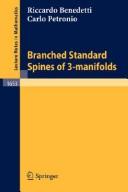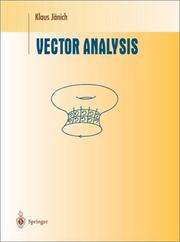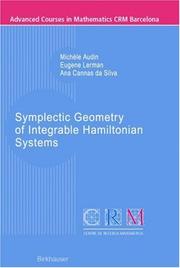| Listing 1 - 10 of 144 | << page >> |
Sort by
|
Book
ISBN: 3319941313 3319941321 Year: 2018 Publisher: Cham : Springer International Publishing : Imprint: Springer,
Abstract | Keywords | Export | Availability | Bookmark
 Loading...
Loading...Choose an application
- Reference Manager
- EndNote
- RefWorks (Direct export to RefWorks)
This book provides a detailed introduction to the coarse quasi-isometry of leaves of a foliated space and describes the cases where the generic leaves have the same quasi-isometric invariants. Every leaf of a compact foliated space has an induced coarse quasi-isometry type, represented by the coarse metric defined by the length of plaque chains given by any finite foliated atlas. When there are dense leaves either all dense leaves without holonomy are uniformly coarsely quasi-isometric to each other, or else every leaf is coarsely quasi-isometric to just meagerly many other leaves. Moreover, if all leaves are dense, the first alternative is characterized by a condition on the leaves called coarse quasi-symmetry. Similar results are proved for more specific coarse invariants, like growth type, asymptotic dimension, and amenability. The Higson corona of the leaves is also studied. All the results are richly illustrated with examples. The book is primarily aimed at researchers on foliated spaces. More generally, specialists in geometric analysis, topological dynamics, or metric geometry may also benefit from it.
Book
ISBN: 9789811517396 9811517398 Year: 2019 Publisher: Singapore Springer Nature Singapore :Imprint: Springer
Abstract | Keywords | Export | Availability | Bookmark
 Loading...
Loading...Choose an application
- Reference Manager
- EndNote
- RefWorks (Direct export to RefWorks)
This book is a posthumous publication of a classic by Prof. Shoshichi Kobayashi, who taught at U.C. Berkeley for 50 years, recently translated by Eriko Shinozaki Nagumo and Makiko Sumi Tanaka. There are five chapters: 1. Plane Curves and Space Curves; 2. Local Theory of Surfaces in Space; 3. Geometry of Surfaces; 4. Gauss–Bonnet Theorem; and 5. Minimal Surfaces. Chapter 1 discusses local and global properties of planar curves and curves in space. Chapter 2 deals with local properties of surfaces in 3-dimensional Euclidean space. Two types of curvatures — the Gaussian curvature K and the mean curvature H —are introduced. The method of the moving frames, a standard technique in differential geometry, is introduced in the context of a surface in 3-dimensional Euclidean space. In Chapter 3, the Riemannian metric on a surface is introduced and properties determined only by the first fundamental form are discussed. The concept of a geodesic introduced in Chapter 2 is extensively discussed, and several examples of geodesics are presented with illustrations. Chapter 4 starts with a simple and elegant proof of Stokes’ theorem for a domain. Then the Gauss–Bonnet theorem, the major topic of this book, is discussed at great length. The theorem is a most beautiful and deep result in differential geometry. It yields a relation between the integral of the Gaussian curvature over a given oriented closed surface S and the topology of S in terms of its Euler number χ(S). Here again, many illustrations are provided to facilitate the reader’s understanding. Chapter 5, Minimal Surfaces, requires some elementary knowledge of complex analysis. However, the author retained the introductory nature of this book and focused on detailed explanations of the examples of minimal surfaces given in Chapter 2. .
Book
ISBN: 9781493996445 1493996444 Year: 2019 Publisher: New York, NY : Springer US : Imprint: Springer,
Abstract | Keywords | Export | Availability | Bookmark
 Loading...
Loading...Choose an application
- Reference Manager
- EndNote
- RefWorks (Direct export to RefWorks)
This book provides a comprehensive introduction to Submanifold theory, focusing on general properties of isometric and conformal immersions of Riemannian manifolds into space forms. One main theme is the isometric and conformal deformation problem for submanifolds of arbitrary dimension and codimension. Several relevant classes of submanifolds are also discussed, including constant curvature submanifolds, submanifolds of nonpositive extrinsic curvature, conformally flat submanifolds and real Kaehler submanifolds. This is the first textbook to treat a substantial proportion of the material presented here. The first chapters are suitable for an introductory course on Submanifold theory for students with a basic background on Riemannian geometry. The remaining chapters could be used in a more advanced course by students aiming at initiating research on the subject, and are also intended to serve as a reference for specialists in the field.
Book
ISBN: 3030284336 3030284328 Year: 2019 Publisher: Cham : Springer International Publishing : Imprint: Springer,
Abstract | Keywords | Export | Availability | Bookmark
 Loading...
Loading...Choose an application
- Reference Manager
- EndNote
- RefWorks (Direct export to RefWorks)
This book aims to provide a friendly introduction to non-commutative geometry. It studies index theory from a classical differential geometry perspective up to the point where classical differential geometry methods become insufficient. It then presents non-commutative geometry as a natural continuation of classical differential geometry. It thereby aims to provide a natural link between classical differential geometry and non-commutative geometry. The book shows that the index formula is a topological statement, and ends with non-commutative topology.
Differential geometry. --- Manifolds (Mathematics). --- Complex manifolds. --- Differential Geometry. --- Manifolds and Cell Complexes (incl. Diff.Topology). --- Analytic spaces --- Manifolds (Mathematics) --- Geometry, Differential --- Topology --- Differential geometry --- Geometry, Differential.
Book
ISBN: 9781441974426 1441974423 Year: 2011 Publisher: New York, NY : Springer New York : Imprint: Springer,
Abstract | Keywords | Export | Availability | Bookmark
 Loading...
Loading...Choose an application
- Reference Manager
- EndNote
- RefWorks (Direct export to RefWorks)
The theory of function spaces endowed with the topology of pointwise convergence, or Cp-theory, exists at the intersection of three important areas of mathematics: topological algebra, functional analysis, and general topology. Cp-theory has an important role in the classification and unification of heterogeneous results from each of these areas of research. Through over 500 carefully selected problems and exercises, this volume provides a self-contained introduction to Cp-theory and general topology. By systematically introducing each of the major topics in Cp-theory, this volume is designed to bring a dedicated reader from basic topological principles to the frontiers of modern research. Key features include: - A unique problem-based introduction to the theory of function spaces. - Detailed solutions to each of the presented problems and exercises. - A comprehensive bibliography reflecting the state-of-the-art in modern Cp-theory. - Numerous open problems and directions for further research. This volume can be used as a textbook for courses in both Cp-theory and general topology as well as a reference guide for specialists studying Cp-theory and related topics. This book also provides numerous topics for PhD specialization as well as a large variety of material suitable for graduate research.
Algebraic topology --- Differential topology --- Topology --- topologie (wiskunde) --- topologie --- Topology. --- Algebraic topology. --- Manifolds (Mathematics) --- Complex manifolds. --- Algebraic Topology. --- Manifolds and Cell Complexes (incl. Diff.Topology).
Book
ISBN: 038748101X Year: 2008 Publisher: New York, NY : Springer New York : Imprint: Springer,
Abstract | Keywords | Export | Availability | Bookmark
 Loading...
Loading...Choose an application
- Reference Manager
- EndNote
- RefWorks (Direct export to RefWorks)
Manifolds, the higher-dimensional analogs of smooth curves and surfaces, are fundamental objects in modern mathematics. Combining aspects of algebra, topology, and analysis, manifolds have also been applied to classical mechanics, general relativity, and quantum field theory. In this streamlined introduction to the subject, the theory of manifolds is presented with the aim of helping the reader achieve a rapid mastery of the essential topics. By the end of the book the reader should be able to compute, at least for simple spaces, one of the most basic topological invariants of a manifold, its de Rham cohomology. Along the way the reader acquires the knowledge and skills necessary for further study of geometry and topology. The requisite point-set topology is included in an appendix of twenty pages; other appendices review facts from real analysis and linear algebra. Hints and solutions are provided to many of the exercises and problems. This work may be used as the text for a one-semester graduate or advanced undergraduate course, as well as by students engaged in self-study. Requiring only minimal undergraduate prerequisites, An Introduction to Manifolds is also an excellent foundation for Springer GTM 82, Differential Forms in Algebraic Topology. .

ISBN: 3540626271 3540683453 9783540626275 Year: 1997 Volume: 1653 Publisher: Berlin: Springer,
Abstract | Keywords | Export | Availability | Bookmark
 Loading...
Loading...Choose an application
- Reference Manager
- EndNote
- RefWorks (Direct export to RefWorks)
This book provides a unified combinatorial realization of the categroies of (closed, oriented) 3-manifolds, combed 3-manifolds, framed 3-manifolds and spin 3-manifolds. In all four cases the objects of the realization are finite enhanced graphs, and only finitely many local moves have to be taken into account. These realizations are based on the notion of branched standard spine, introduced in the book as a combination of the notion of branched surface with that of standard spine. The book is intended for readers interested in low-dimensional topology, and some familiarity with the basics is assumed. A list of questions, some of which concerning relations with the theory of quantum invariants, is enclosed.
Differential geometry. Global analysis --- Three-manifolds (Topology) --- Mathematical Theory --- Geometry --- Mathematics --- Physical Sciences & Mathematics --- Drie-menigvuldigheden (Topologie) --- Trois-variétés (Topologie) --- Manifolds (Mathematics). --- Complex manifolds. --- Manifolds and Cell Complexes (incl. Diff.Topology). --- Analytic spaces --- Manifolds (Mathematics) --- Geometry, Differential --- Topology
Book
ISBN: 4431552154 4431552146 Year: 2014 Publisher: Tokyo : Springer Japan : Imprint: Springer,
Abstract | Keywords | Export | Availability | Bookmark
 Loading...
Loading...Choose an application
- Reference Manager
- EndNote
- RefWorks (Direct export to RefWorks)
Edited in collaboration with the Grassmann Research Group, this book contains many important articles delivered at the ICM 2014 Satellite Conference and the 18th International Workshop on Real and Complex Submanifolds, which was held at the National Institute for Mathematical Sciences, Daejeon, Republic of Korea, August 10–12, 2014. The book covers various aspects of differential geometry focused on submanifolds, symmetric spaces, Riemannian and Lorentzian manifolds, and Kähler and Grassmann manifolds.
Submanifolds --- Geometry, Differential --- Manifolds (Mathematics) --- Global differential geometry. --- Cell aggregation --- Differential Geometry. --- Manifolds and Cell Complexes (incl. Diff.Topology). --- Mathematics. --- Aggregation, Cell --- Cell patterning --- Cell interaction --- Microbial aggregation --- Differential geometry. --- Manifolds (Mathematics). --- Complex manifolds. --- Analytic spaces --- Topology --- Differential geometry

ISBN: 0387986499 1441931449 1475734786 9780387986494 Year: 2001 Publisher: Berlin: Springer,
Abstract | Keywords | Export | Availability | Bookmark
 Loading...
Loading...Choose an application
- Reference Manager
- EndNote
- RefWorks (Direct export to RefWorks)
Classical vector analysis deals with vector fields; the gradient, divergence, and curl operators; line, surface, and volume integrals; and the integral theorems of Gauss, Stokes, and Green. Modern vector analysis distills these into the Cartan calculus and a general form of Stokes' theorem. This essentially modern text carefully develops vector analysis on manifolds and reinterprets it from the classical viewpoint (and with the classical notation) for three-dimensional Euclidean space, then goes on to introduce de Rham cohomology and Hodge theory. The material is accessible to an undergraduate student with calculus, linear algebra, and some topology as prerequisites. The many figures, exercises with detailed hints, and tests with answers make this book particularly suitable for anyone studying the subject independently.
Mathematical physics --- Vector analysis --- 512.6 --- oefeningen --- vectoren --- Algebra, Universal --- Mathematics --- Numbers, Complex --- Quaternions --- Spinor analysis --- Vector algebra --- Vector analysis. --- Analyse vectorielle --- Manifolds (Mathematics). --- Complex manifolds. --- Manifolds and Cell Complexes (incl. Diff.Topology). --- Analytic spaces --- Manifolds (Mathematics) --- Geometry, Differential --- Topology

ISBN: 3764321679 3034880715 9783764321673 Year: 2003 Publisher: Basel: Springer,
Abstract | Keywords | Export | Availability | Bookmark
 Loading...
Loading...Choose an application
- Reference Manager
- EndNote
- RefWorks (Direct export to RefWorks)
Among all the Hamiltonian systems, the integrable ones have special geometric properties; in particular, their solutions are very regular and quasi-periodic. The quasi-periodicity of the solutions of an integrable system is a result of the fact that the system is invariant under a (semi-global) torus action. It is thus natural to investigate the symplectic manifolds that can be endowed with a (global) torus action. This leads to symplectic toric manifolds (Part B of this book). Physics makes a surprising come-back in Part A: to describe Mirror Symmetry, one looks for a special kind of Lagrangian submanifolds and integrable systems, the special Lagrangians. Furthermore, integrable Hamiltonian systems on punctured cotangent bundles are a starting point for the study of contact toric manifolds (Part C of this book).
Differential geometry. Global analysis --- Differential geometry. --- Manifolds (Mathematics). --- Complex manifolds. --- Physics. --- Differential Geometry. --- Manifolds and Cell Complexes (incl. Diff.Topology). --- Mathematical Methods in Physics. --- Natural philosophy --- Philosophy, Natural --- Physical sciences --- Dynamics --- Analytic spaces --- Manifolds (Mathematics) --- Geometry, Differential --- Topology --- Differential geometry
| Listing 1 - 10 of 144 | << page >> |
Sort by
|

 Search
Search Feedback
Feedback About UniCat
About UniCat  Help
Help News
News